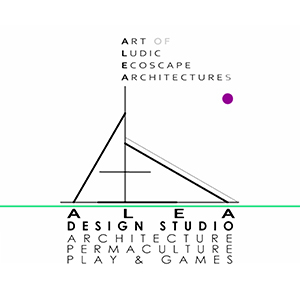|
TRADEMARK – LOGO
Architectural Office - ALEA Design Studio - Stavros Mouzakitis & Associates
| Description Report
The presented (pending application for registration) Trademark (Illustrative with Words) is designed as the Logo of the Architectural Office with the brand name A.L.E.A. DESIGN STUDIO, which is based in Patras and operates in the Greek territory, under the responsibility of Dr. Architect Engineer Stavros Mouzakitis, offering modern Architectural Design Services.
In particular, the office undertakes all kinds of architectural studies and the required works for the issuance of building, renovation and restoration permits of residential buildings, offices, shops, schools, cultural centers, etc., in accordance with modern principles of Ecological - Bioclimatic Planning.
Also, our office undertakes configurations of outdoor spaces - gardens, squares, parks and playgrounds - private and public, according to modern design principles of landscape architecture (urban and "natural"), in the special direction of Regenerative Agri-Culture or "Permaculture" (Permanent Agriculture), which emphasizes the creation of integrated productive ecosystems, of increased biodiversity.
Finally, the services of the office also include the Design of "Serious" Games, i.e. games whose purposes go beyond simple entertainment, emphasizing various issues (ecological, socio-political, psychological etc.), highlighting their particular value as basic means of Educational Entertainment (Educational Entertainment = “Edutainment”).
Given the above, the presented Logo attempts to render, in an (as much as possible) abstract but also playful graphic way, all these basic directions of the office's design work, as well as its brand name itself (ALEA), which, among a multitude of conceptual references (see below), emerges as an acronym for the English phrase "Art of Ludic Ecoscape Architectures", ie. a complex design strategy developed during the academic research activity of the office’s manager and is attempted to be promoted through his current and future professional work.
More specifically, the graphic part of the logo is composed of two basic right-angled triangles, with opposing angles of 30° and 60°, placed in a 90° rotation relationship (the left one based on its short side and the left one based on its long side), so that, in combination with some additional graphic interventions - movements (such as the addition and lengthening of certain linear elements, the introduction of a circular one, but also the listing of verbal elements, with "strategic" placement and tonal-color differentiation among them), to abstractly render both the letters of the brand, as well as a form capable of refering to a diagrammatic architectural section plan of an ideal building, which is estimated to bear certain typical characteristics of a Playful "Eco-Landscape" Architecture.
Why ALEA? Origin and meanings of the word.
ālea f (genitive āleae); first declension
1. Ancient polychne of Arcadia. Its founder was Aleos, a descendant of Afidamantas. It was located in the homonymous plain and after Stymphilos, on the ancient road that led from Argolis to Arcadia. In the city there were temples of Artemis Ephesia, Athena Alea and Dionysus, with a statue of the god. Every year there took place the Skieria, a celebration dedicated to the god Dionysus. The location of the ancient city has not been found, but it is identified in the area near the present village of Alea.
2. The tree line/ the road beside tree lines. Loanword from French allée (tree line) 3. “Eulalia”: sweetly-speaking, well-spoken (from ancient Greek “eu/εὖ” = good + “laléō/λᾰλέω” = to speak/ talk)
4. Noble: Frisian short form of names beginning with “Adel-“, which means “noble” in Frisian.
5. Aaliyah: variant of the Hebrew name Aaliyah, which means “to ascend”, “rising”, “high”, “lofty”, “elevated”, “sublime” or “noble”.
6. Dice: In Latin, it means and “cubes” and “dice” (originally "pivot-bone" or "joint-bone", since bones were used as early dice; from axis, via a form *axlea).
7. General Category - Type of Games:
a. games with a die
b. any game involving dice
c. gambling games (games of chance)
According to the Etymologiae by Isidore of Seville, Alea was a Greek soldier of the Trojan War who invented the dicing game tabula.
French sociologist Roger Caillois in Man, Play and Games (1958) uses the term "alea" to designate those games which rely on Luck, Risk and Uncertainty, rather than skill.
* While Caillois notes the term is the Roman word for games of chance, Robert C. Bell suggests that the Greek game tabula, a precursor to modern backgammon, became more commonly known as "alea" "towards the end of the sixth century". However, games historian H. J. R. Murray asserts the shift in nomenclature was in the other direction and the game "alea" was later referred to as "tabula".
Pejorative concept: intellectually inferior form of game, as it relies more on luck and less on mental ability.
Neutral concept: since the ability to manage randomness is one of the basic requirements of the whole "game of life", these games have an equal status with the rest.
Super-honorary concept: symbol of the “Sublime” (High – marginally Divine) concept and attribute of Randomness and Chaos, seen as the ontological condition of Order.
Our concept: Based on all of the above, we choose the name ALEA as a symbol of the inextricable Relationship between Chaos and Order, with the intention of highlighting its fundamental ontological meaning, which operates continuously, both in the background and in the foreground of the architectural design process, if not and of the whole life, in a fundamentally playful way.
|

